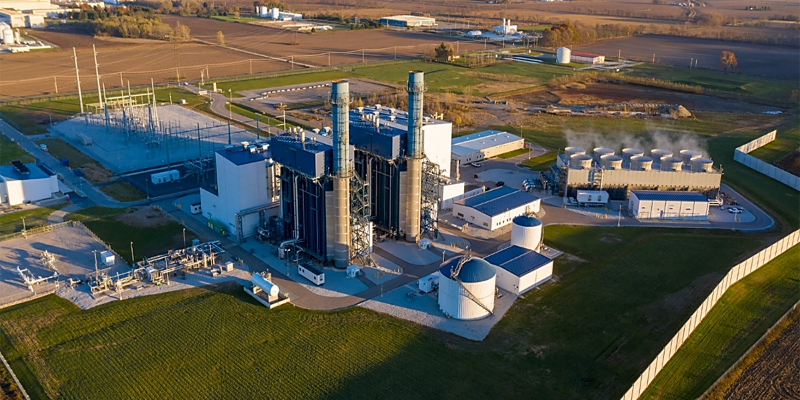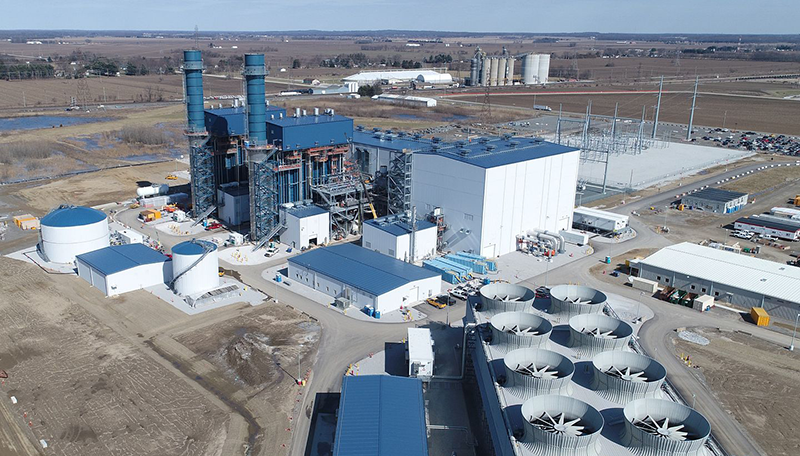Two G&T Co-ops Collaborate on Natural Gas Asset Acquisition

Hoosier Energy and Wabash Valley Power Alliance (WVPA) recently collaborated on the purchase of St. Joseph Energy Center (St. Joe), a 720-megawatt combined cycle natural gas plant located in New Carlisle, Indiana. The decision to work together was driven by a shared history of strategic partnerships and a commitment to delivering reliable and affordable energy solutions.
Hoosier Energy is based in Bloomington, Indiana, and serves 17 distribution cooperatives with more than 700,000 consumers. WVPA is based in Indianapolis, Indiana, and serves 23 distribution cooperatives in Indiana, Illinois and Missouri with more than 330,000 members.
In early 2024, both organizations recognized that St. Joe represented an exceptional opportunity to enhance system reliability and ensure cost-effective energy generation today and into the future.
“For Hoosier Energy, this acquisition aligns seamlessly with our long-term resource plan priorities, reflecting our commitment to prudent investment and sustainable energy solutions,” Hoosier Energy CFO Jon Jackson said. “Our longstanding relationship with WVPA, strengthened by previous co-ownership of the Holland combined-cycle plant in Illinois, provided a foundation of trust and shared vision.”
“By working together on this acquisition, we not only leveraged the strengths of our longstanding collaboration but also mitigated risks to our respective resource portfolios and financial positions,” WVPA Vice President of Generation Albert Taylor said. “A joint ownership structure allowed us to align the capacity shares of St. Joe more effectively with the unique, evolving needs of each organization’s resource strategy.”
Talks Began in January 2024
Talks between three utilities started in January 2024 on the potential acquisition of the plant.
“As the process unfolded, a third party we were working with decided to step away later that spring,” Taylor said. “That created a unique opportunity for Hoosier Energy and WPVA to step in as equal partners.”
Both generation and transmission (G&T) cooperatives quickly recognized the strategic value of collaborating to jointly purchase the plant. The decision to partner on the acquisition enabled a streamlined approach to decision-making and due diligence.
In mid-March, after just over a year of collaborative efforts, the two G&Ts successfully closed the acquisition.
The decision to purchase an existing and operational asset instead of building a new generation plant was based on mitigating risk.
“If you want to bring new generation online, you’re looking at a time period of probably six to seven years, and there are a lot of risks associated with that option,” Jackson said. “You have the transmission queue risk, timing risk and new technology risk. Identifying an asset that already existed and was generating power eliminated certain risks associated with building new generation.”
Working Together Reduced Financial, Operational Risk
Jointly acquiring the plant not only reduced financial and operational risk, but also improved processes and efficiencies.
“In addition to risk mitigation, the shared ownership model provides an opportunity to optimize workload and asset management,” Taylor said. “By leveraging the combined expertise and resources of both organizations, we can enhance operational efficiency and streamline responsibilities.”
Together, both G&Ts are better equipped to navigate the complexities of the energy sector and continue to provide reliable, affordable energy to the communities they serve.
“The collaboration not only ensures an optimal fit for our resource needs but also reinforces our commitment to prudent stewardship and strategic alliances,” Jackson said. “This acquisition exemplifies the power of cooperation in achieving greater stability, efficiency and value for our members while navigating the complexities of the evolving energy landscape.”
St. Joe Energy Center is a state-of-the-art, highly efficient and reliable generation resource that integrates seamlessly into both G&Ts’ power portfolios. The newly acquired plant will play a critical role in replacing retiring infrastructure and expiring power supply contracts.
The tight timeline from initial conversations in January 2024 to acquisition in March created the most significant challenge: funding the deal.
Biggest Challenge was Funding the Deal
Both G&Ts identified Rural Utilities Service (RUS) financing as the optimal solution due to its low-cost advantages. However, the approval process for RUS loans can extend up to two years, creating a timing constraint that needed to be addressed.
“Recognizing the importance of timely action, we proactively engaged our banking group early in the process,” Jackson said. “This group, composed of trusted partners, provided unwavering support and enabled us to explore a range of financing strategies tailored to the transaction’s needs.”
The cooperatives conducted thorough reviews by evaluating multiple strategic options to ensure alignment with their organizational priorities.
“Ultimately, we opted for a bridge facility—a two-plus year solution—designed to provide the flexibility needed to pursue long-term financing through RUS,” Jackson said. “This interim measure allowed us to work within the RUS lending window while mitigating the risks associated with timing constraints.”
Once the decision was made to use RUS for long-term funding, both G&Ts worked closely with CFC to establish bridge loan facilities.
“The interim financing solution ensured that funds were readily available for the acquisition while allowing both cooperatives to remain on track to secure RUS financing in the future,” Taylor said. “The partnership with CFC provided the flexibility and financial agility necessary to meet immediate needs without compromising long-term financial goals.”
Together, the G&Ts and CFC structured bridge loans that facilitated the acquisition and positioned them to pursue long-term RUS financing.
“The partnership with CFC was instrumental in facilitating the acquisition of St. Joe,” Jackson said. “CFC has consistently demonstrated its value as a lending partner, offering not only access to capital, but also innovative and customized solutions tailored to our specific needs.”
Advice for G&T Cooperative Leaders
For G&T cooperative leaders considering purchasing generation resources, Jackson recommended having a solid financial policy anchored in long-term strategic objectives as a critical factor for success.
“Prioritize forward planning and develop tools that enable informed, consistent decision-making,” Jackson said. “By maintaining a disciplined approach to financial management and resource planning, cooperatives can navigate the complexities of acquiring generation resources while positioning themselves for long-term success.”
Taylor’s advice for G&T leaders is to embrace collaboration and innovation.
“As G&Ts, we share core values and business models, which creates a strong foundation for partnerships,” Taylor said. “We do not hesitate to explore opportunities to work with like-minded cooperatives. The foundation we have with Hoosier allows us to confidently enter into a joint venture which allows us to reduce risk, optimize resource allocation and deliver benefits that may be more challenging to achieve independently. Equally as important is adopting a creative and forward-thinking approach to funding these types of projects. Together, we can navigate challenges, seize opportunities and continue delivering reliable and affordable energy to our members.”
 St. Joseph Energy Center.
St. Joseph Energy Center.